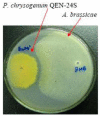Secondary metabolites from a marine-derived endophytic fungus Penicillium chrysogenum QEN-24S
- PMID: 21339945
- PMCID: PMC3039470
- DOI: 10.3390/md9010059
Secondary metabolites from a marine-derived endophytic fungus Penicillium chrysogenum QEN-24S
Abstract
Penicillium chrysogenum QEN-24S, an endophytic fungus isolated from an unidentified marine red algal species of the genus Laurencia, displayed inhibitory activity against the growth of pathogen Alternaria brassicae in dual culture test. Chemical investigation of this fungal strain resulted in the isolation of four new (1-3 and 5) and one known (4) secondary metabolites. Their structures were identified as two polyketide derivatives penicitides A and B (1 and 2), two glycerol derivatives 2-(2,4-dihydroxy-6-methylbenzoyl)-glycerol (3) and 1-(2,4-dihydroxy-6-methylbenzoyl)- glycerol (4), and one monoterpene derivative penicimonoterpene (5). Penicitides A and B (1 and 2) feature a unique 10-hydroxy- or 7,10-dihydroxy-5,7-dimethylundecyl moiety substituting at C-5 of the α-tetrahydropyrone ring, which is not reported previously among natural products. Compound 5 displayed potent activity against the pathogen A. brassicae, while compound 1 exhibited moderate cytotoxic activity against the human hepatocellular liver carcinoma cell line.
Keywords: Penicillium chrysogenum; marine endophyte; secondary metabolites.
Figures





Similar articles
-
Penicisteroids A and B, antifungal and cytotoxic polyoxygenated steroids from the marine alga-derived endophytic fungus Penicillium chrysogenum QEN-24S.Bioorg Med Chem Lett. 2011 May 15;21(10):2894-7. doi: 10.1016/j.bmcl.2011.03.076. Epub 2011 Mar 29. Bioorg Med Chem Lett. 2011. PMID: 21489788
-
Secondary metabolites from marine fungus Penicillium chrysogenum VH17 and their antimicrobial and cytotoxic potential.Biosci Biotechnol Biochem. 2024 Oct 22;88(11):1254-1260. doi: 10.1093/bbb/zbae113. Biosci Biotechnol Biochem. 2024. PMID: 39152047
-
Antimicrobial Meroterpenoids and Erythritol Derivatives Isolated from the Marine-Algal-Derived Endophytic Fungus Penicillium chrysogenum XNM-12.Mar Drugs. 2020 Nov 20;18(11):578. doi: 10.3390/md18110578. Mar Drugs. 2020. PMID: 33233849 Free PMC article.
-
The Cytotoxic Activity of Secondary Metabolites from Marine-Derived Penicillium spp.: A Review (2018-2024).Mar Drugs. 2025 Apr 30;23(5):197. doi: 10.3390/md23050197. Mar Drugs. 2025. PMID: 40422787 Free PMC article. Review.
-
Marine-Derived Penicillium Species as Producers of Cytotoxic Metabolites.Mar Drugs. 2017 Oct 24;15(10):329. doi: 10.3390/md15100329. Mar Drugs. 2017. PMID: 29064452 Free PMC article. Review.
Cited by
-
Marine Natural Products from the Beibu Gulf: Sources, Chemistry, and Bioactivities.Mar Drugs. 2023 Jan 19;21(2):63. doi: 10.3390/md21020063. Mar Drugs. 2023. PMID: 36827104 Free PMC article.
-
First total syntheses and antimicrobial evaluation of penicimonoterpene, a marine-derived monoterpenoid, and its various derivatives.Mar Drugs. 2014 Jun 3;12(6):3352-70. doi: 10.3390/md12063352. Mar Drugs. 2014. PMID: 24897384 Free PMC article.
-
Aniquinazolines A-D, four new quinazolinone alkaloids from marine-derived endophytic fungus Aspergillus nidulans.Mar Drugs. 2013 Jul 23;11(7):2682-94. doi: 10.3390/md11072682. Mar Drugs. 2013. PMID: 23880937 Free PMC article.
-
Antitumor Potential of Seaweed Derived-Endophytic Fungi.Antibiotics (Basel). 2019 Oct 31;8(4):205. doi: 10.3390/antibiotics8040205. Antibiotics (Basel). 2019. PMID: 31683523 Free PMC article. Review.
-
The Biocontrol and Growth-Promoting Potential of Penicillium spp. and Trichoderma spp. in Sustainable Agriculture.Plants (Basel). 2025 Jun 30;14(13):2007. doi: 10.3390/plants14132007. Plants (Basel). 2025. PMID: 40648017 Free PMC article.
References
-
- Bugni TS, Ireland CM. Marine-derived fungi: A chemically and biologically diverse group of microorganisms. Nat Prod Rep. 2004;21:143–163. - PubMed
-
- Blunt JW, Copp BR, Hu WP, Munro MHG, Northcote PT, Prinsep MR. Marine natural products. Nat Prod Rep. 2008;25:35–94. - PubMed
-
- Blunt JW, Copp BR, Hu WP, Munro MHG, Northcote PT, Prinsep MR. Marine natural products. Nat Prod Rep. 2009;26:170–244. - PubMed
-
- Blunt JW, Copp BR, Munro MHG, Northcote PT, Prinsep MR. Marine natural products. Nat Prod Rep. 2010;27:165–237. - PubMed
-
- Zhang Y, Li XM, Wang BG. Nigerasperones A–C, new monomeric and dimeric naphtho-γ-pyrones from a marine alga-derived endophytic fungus Aspergillus niger EN-13. J Antibiot. 2007;60:204–210. - PubMed
Publication types
MeSH terms
Substances
Associated data
- Actions
LinkOut - more resources
Full Text Sources
Miscellaneous
